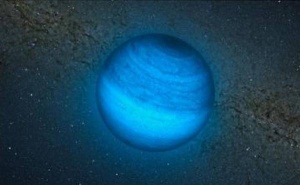CFBDSIR 2149-0403
Da Ufopedia.
| (Una revisione intermedia non mostrata.) | |||
| Riga 2: | Riga 2: | ||
[[Immagine:1352904839446_pianeta.jpg|thumb|right|300px|Rappresentazione artistica del pianeta vagabondo (fonte: L. Calçada, P. Delorme, Nick Risinger, R. Saito, European Southern Observatory/VVV Consortium).]] | [[Immagine:1352904839446_pianeta.jpg|thumb|right|300px|Rappresentazione artistica del pianeta vagabondo (fonte: L. Calçada, P. Delorme, Nick Risinger, R. Saito, European Southern Observatory/VVV Consortium).]] | ||
| - | '''CFBDSIR 2149-0403''' (full designation '''CFBDSIR J214947.2-040308.9''') is a [[brown dwarf]] and probable [[rogue planet]],<ref name="bbc">{{cite web|title='Rogue planet' spotted 100 light-years away|url=http://www.bbc.co.uk/news/science-environment-20309762|publisher=BBC|accessdate=14 November 2012|date=14 November 2012}}</ref> likely (with 87% probability) part of the [[AB Doradus moving group]] as indicated by its position and [[proper motion]]. | + | '''CFBDSIR 2149-0403''' (full designation '''CFBDSIR J214947.2-040308.9''') is a [[brown dwarf]] and probable [[rogue planet]],<ref name="bbc">{{cite web|title='Rogue planet' spotted 100 light-years away|url=http://www.bbc.co.uk/news/science-environment-20309762|publisher=BBC|accessdate=14 November 2012|date=14 November 2012}}</ref> likely (with 87% probability) part of the [[AB Doradus moving group]] as indicated by its position and [[proper motion]].<ref name="bbc"></ref> Its age is estimated to be between 20 and 200 million years. |
==Discovery== | ==Discovery== | ||
CFBDSIR 2149-0403 has been discovered by the [[Canada-France Brown Dwarfs Survey]], a [[near infrared]] sky survey, and confirmed by [[Wide-field Infrared Survey Explorer|WISE]] data. | CFBDSIR 2149-0403 has been discovered by the [[Canada-France Brown Dwarfs Survey]], a [[near infrared]] sky survey, and confirmed by [[Wide-field Infrared Survey Explorer|WISE]] data. | ||
==Distance== | ==Distance== | ||
| - | As of November 2012, this rogue planet is the closest that has ever been spotted.<ref>{{cite web|title=Astronomers find 'homeless' planet wandering through space|url=http://phys.org/news/2012-11-astronomers-homeless-planet-space.html|publisher=Phys.org|accessdate=14 November 2012|date=14 November 2012}}</ref> If the object belongs to the AB Doradus moving group then its distance is estimated to be 40±4 [[parsecs]] (130±13 light years) from Earth; other possible estimates range from 25 to 50 parsecs. | + | As of November 2012, this rogue planet is the closest that has ever been spotted.<ref>{{cite web|title=Astronomers find 'homeless' planet wandering through space|url=http://phys.org/news/2012-11-astronomers-homeless-planet-space.html|publisher=Phys.org|accessdate=14 November 2012|date=14 November 2012}}</ref> If the object belongs to the AB Doradus moving group then its distance is estimated to be 40±4 [[parsecs]] (130±13 light years) from Earth; other possible estimates range from 25 to 50 parsecs. |
==Atmosphere== | ==Atmosphere== | ||
Versione attuale delle 10:13, 13 giu 2013
| Questa voce ha bisogno di essere tradotta. |
CFBDSIR 2149-0403 (full designation CFBDSIR J214947.2-040308.9) is a brown dwarf and probable rogue planet,[1] likely (with 87% probability) part of the AB Doradus moving group as indicated by its position and proper motion.[1] Its age is estimated to be between 20 and 200 million years.
Indice |
Discovery
CFBDSIR 2149-0403 has been discovered by the Canada-France Brown Dwarfs Survey, a near infrared sky survey, and confirmed by WISE data.
Distance
As of November 2012, this rogue planet is the closest that has ever been spotted.[2] If the object belongs to the AB Doradus moving group then its distance is estimated to be 40±4 parsecs (130±13 light years) from Earth; other possible estimates range from 25 to 50 parsecs.
Atmosphere
Spectroscopy observations have found absorption by gaseous methane and water.
